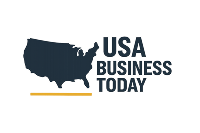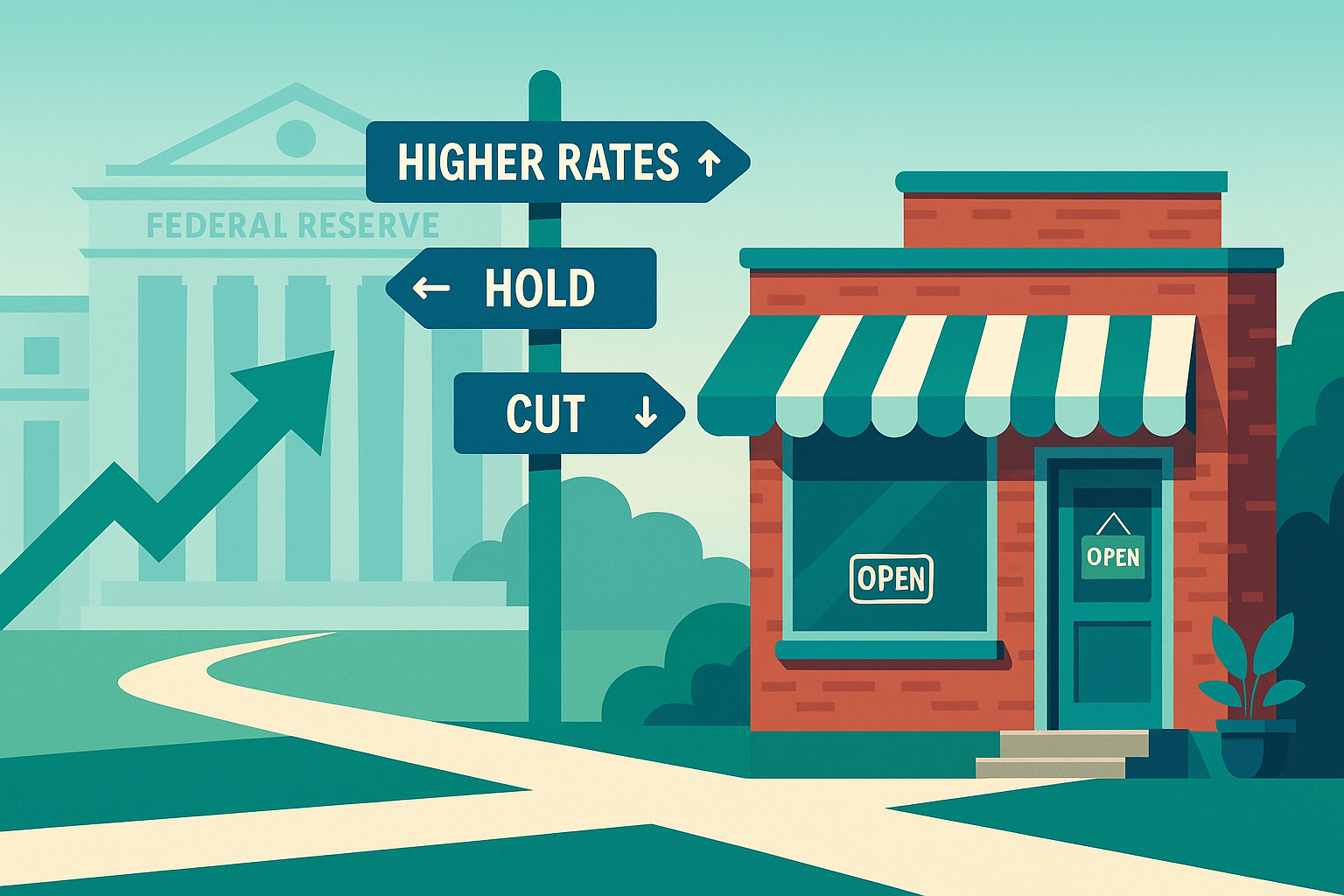The Federal Reserve ended 2024 on a delicate plateau, parking the federal-funds rate in a 7.25 – 7.50 percent target range and insisting it would “stay higher for longer” until inflation finished its long, stubborn descent. By May 2025 the policy needle still hadn’t budged. Core inflation has cooled but remains sticky, unemployment hovers a hair above 4 percent, and headline GDP growth looks uninspiring at best. Fed officials now face three realistic paths for the second half of the year—a precautionary quarter-point hike, an extended hold, or the first cut since 2020—and every option carries sharply different consequences for America’s 33 million small businesses.
Below, we unpack how each scenario could ricochet through Main-Street balance sheets, loan terms, hiring plans, and long-term investment—and what owners can do right now to keep their cash flow safe no matter which road the Fed chooses.
Where things stand in May 2025
- Policy rate: 7.25 – 7.50 percent (unchanged since December).
- Prime rate: 7.50 percent, driving SBA 7(a) loan caps as high as 14 percent for micro-loans. NerdWallet
- Small-business optimism: NFIB’s headline index fell to 95.8 in April, its second month below the 51-year average, with credit conditions a top concern. NFIB – NFIB Small Business Association
- Fed rhetoric: Chair Jerome Powell repeated on May 7 that the Committee is “prepared to move in either direction,” citing upside inflation risk alongside pockets of labor-market cooling. BankrateThe Washington Post
The three fork-in-the-road scenarios
1. The “insurance” hike (+25 bp)
If core services inflation refuses to move lower and wage growth re-accelerates this summer, the Fed may choose a small additional hike as insurance.
What it means on Main Street
- Working-capital squeeze: Variable-rate lines of credit tied to prime would jump to 7.75 percent overnight. A $250 k line fully drawn today at 11.5 percent would reset near 11.75 percent, adding ~$520 in monthly interest.
- SBA 7(a) caps lift again: Maximum variable rates could reach 14.25 percent for smaller loans, pushing many startups to delay equipment purchases.
- Equipment-finance domino: Independent finance companies typically price two points above prime; a hike can stall leasing activity in construction and manufacturing.
Playbook if the Fed hikes
- Lock what you can: Convert floating-rate lines to fixed-rate term notes before the meeting window.
- Extend trade terms carefully: Offer early-pay discounts rather than 60-day open credit; you’ll keep cash moving without taking on new borrowing.
- Slash nonessential CapEx: Defer nice-to-have upgrades (office remodels, light-duty vehicles) until rates plateau.
2. The long hold (status quo through year-end)
The market’s base-case expectation: the Fed stays put, waiting for clearer data.
Main-Street effects
- Higher-for-longer drags on sentiment: NFIB surveys show borrowing plans dive whenever owners believe rates will stay elevated six months or more. NFIB – NFIB Small Business Association
- Marginal credit tightening: Banks keep risk spreads wide. Lenders wary of commercial-real-estate exposure will re-price LOC renewals five-year-treasury + 300 bp or higher.
- Margin compression: Consumer-facing businesses can’t pass through higher interest cost as quickly now that goods inflation is cooling; profits get squeezed.
Playbook if the Fed holds
- Refinance high-rate card balances into SBA micro-loans before year-end caps adjust upward again.
- Negotiate vendor discounts for ACH or debit payments—suppliers prefer prompt cash in a tight-credit world.
- Double-down on variable-cost staffing: Use contractors or part-timers rather than adding full-time heads. You stay nimble if demand softens.
3. The surprise cut (-25 bp in Q4)
Should unemployment rise faster than expected or an external shock dent growth, the Committee could trim rates to cushion the slowdown.
Main-Street upside
- Lower credit-card APRs: A quarter-point cut pares business card rates by the same, saving ~$250 a year per $10 k carried.
- Cheaper floating equipment leases: Many index to SOFR, which would slide with fed-funds.
- Confidence pop: When cuts arrive after a plateau, NFIB optimism typically rebounds six to nine points the following quarter.
But beware the recession signal
Rate cuts often coincide with worsening demand. A 25 bp trim might help interest expense but hurt top-line sales.
Playbook if the Fed cuts
- Swap rate savings into marketing spend to defend revenue while competitors hunker down.
- Grab growth talent: Labor loosens quickly; pick up skilled workers at reasonable salaries.
- Refinance adjustable-rate real-estate debt while spreads haven’t widened.
Five rate-sensitive levers every small business should watch
- Prime-linked business cards & LOCs – adjust the month after any Fed move.
- SBA 7(a) and 504 rates – float quarterly off prime or five-year treasuries; caps shift each Fed action.
- Merchant-cash-advance offers – get more aggressive as liquidity tightens; avoid unless desperate.
- Vendor net terms – suppliers often mirror banks’ risk posture; 2/10 net 30 can disappear in a hike cycle.
- Employee wage expectations – higher rates can cool labor demand, giving owners modest cost relief.
Sector snapshots: who’s most exposed?
| Sector | Interest-rate sensitivity | Why |
|---|---|---|
| Construction trades | High | Heavy use of equipment leases, surety bonds, variable-rate LOCs. |
| Retail e-commerce | Moderate | Card-processing chargebacks rise as consumer credit tightens. |
| Professional services | Low-to-moderate | Billable-hours model cushions rate spikes, but clients may delay big projects. |
| Hospitality | High | Occupancy swings with disposable income; expansions require SBA 504 loans. |
Cash-flow guardrails for any Fed path
- Model three interest scenarios in your 12-month forecast (hike + 50 bp, hold, cut – 50 bp).
- Maintain at least two months of operating expenses in liquidity—line of credit counts only if unused.
- Bundle orders to hit freight-free minimums and offset fast-rising shipping surcharges.
- Shift fixed to floating prudently: If you believe a cut is imminent, refinance a slice of debt to a variable note capped two points below your current rate.
Voices from the field
“We were paying 12.25 percent on our revolving line after the December pause. If the Fed nudges rates even 25 bp higher, that line goes to 12.5 percent—another $600 a month. We’ve already culled two slow-moving SKUs just to keep inventory lean.”
— Alicia Nguyen, owner, Pacific Coast Outdoor Gear, Portland
“My capital-equipment vendor pushed an 8.9 percent fixed lease in 2022; I’m glad I took it. Neighboring shops that stayed variable are staring at 11 percent. A one-point cut would finally let them breathe.”
— Carlos Jiménez, precision machinist, El Paso
Their experiences underline a simple truth: micro decisions about rate structure two years ago define breathing room today.
Looking ahead: the Fed’s data triggers
Inflation target – Core PCE needs to stay below 2.2 percent annualized for at least two consecutive prints to green-light a cut.
Labor slack – Unemployment above 4.5 percent for two quarters historically precedes easing.
Credit-conditions survey – A sharp uptick in C&I loan delinquencies could force pre-emptive cuts.
Stay alert to those signals; they will set the tone for Q4 financing.
Whether the Federal Reserve hikes, holds, or cuts in 2025, small-business owners can’t afford to watch from the bleachers. Each fork in the path changes borrowing costs, customer demand, and expansion appetite in real time. Build flexible forecasts, lock in affordable capital where possible, and keep powder dry for the opportunities a volatile rate cycle always creates.
The crossroads are here—navigate them wisely, and your business can grow no matter which direction the Fed turns next.





